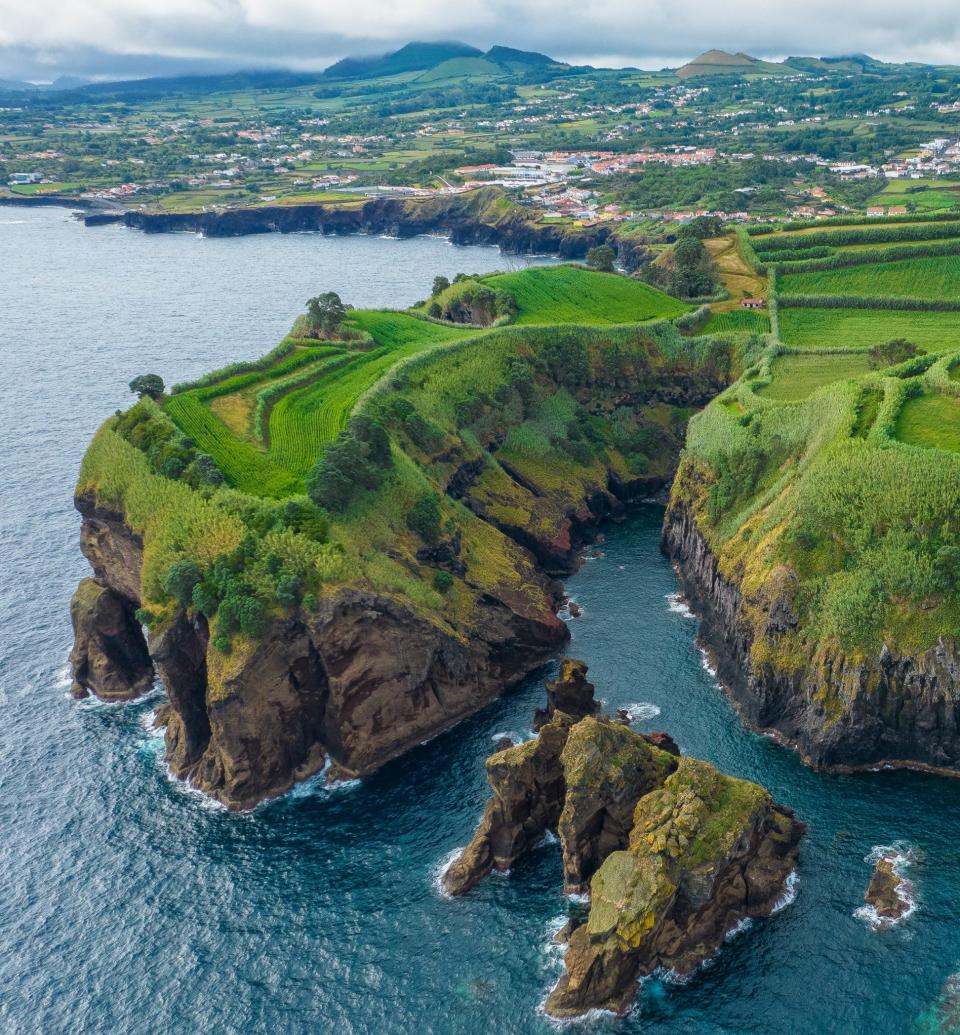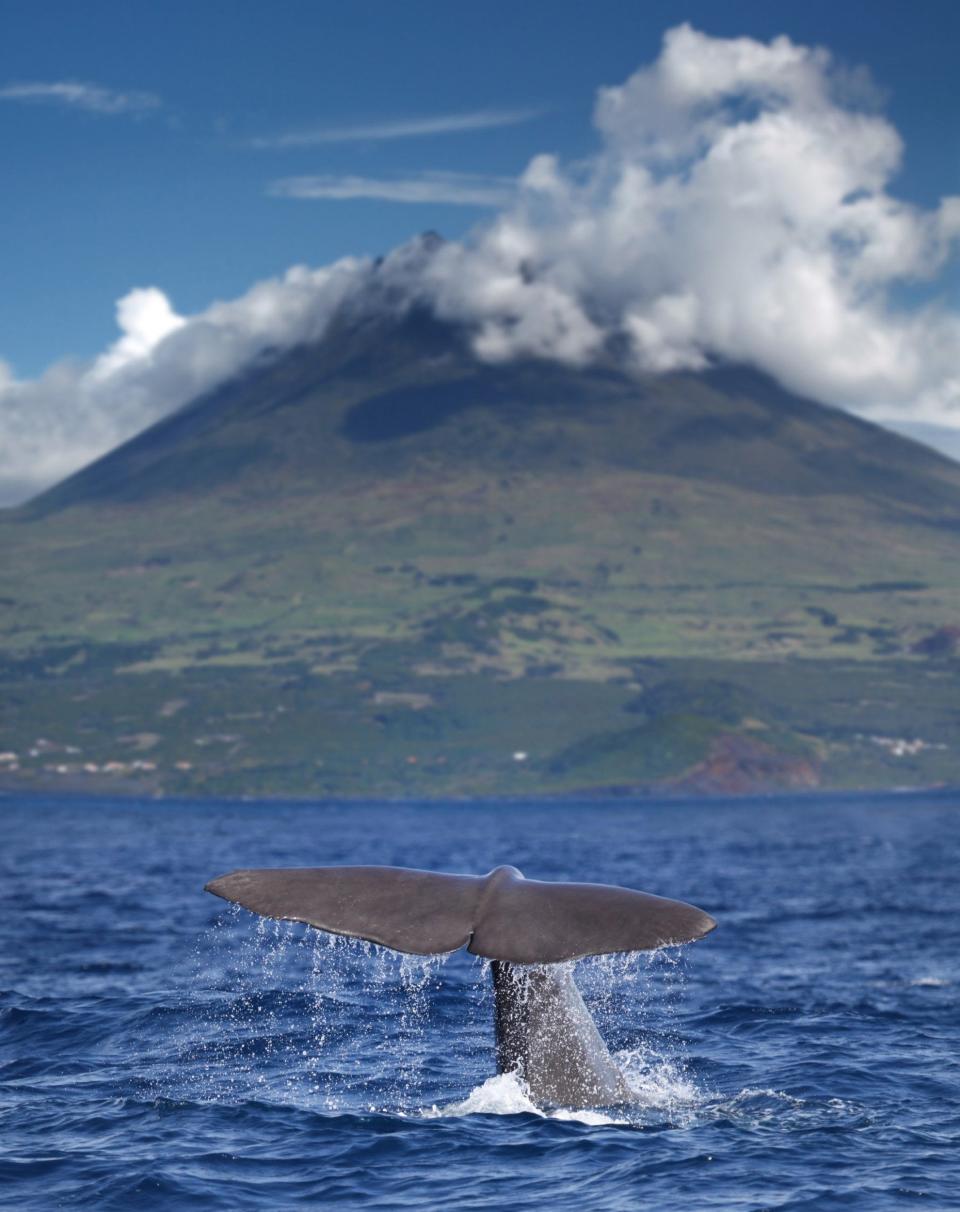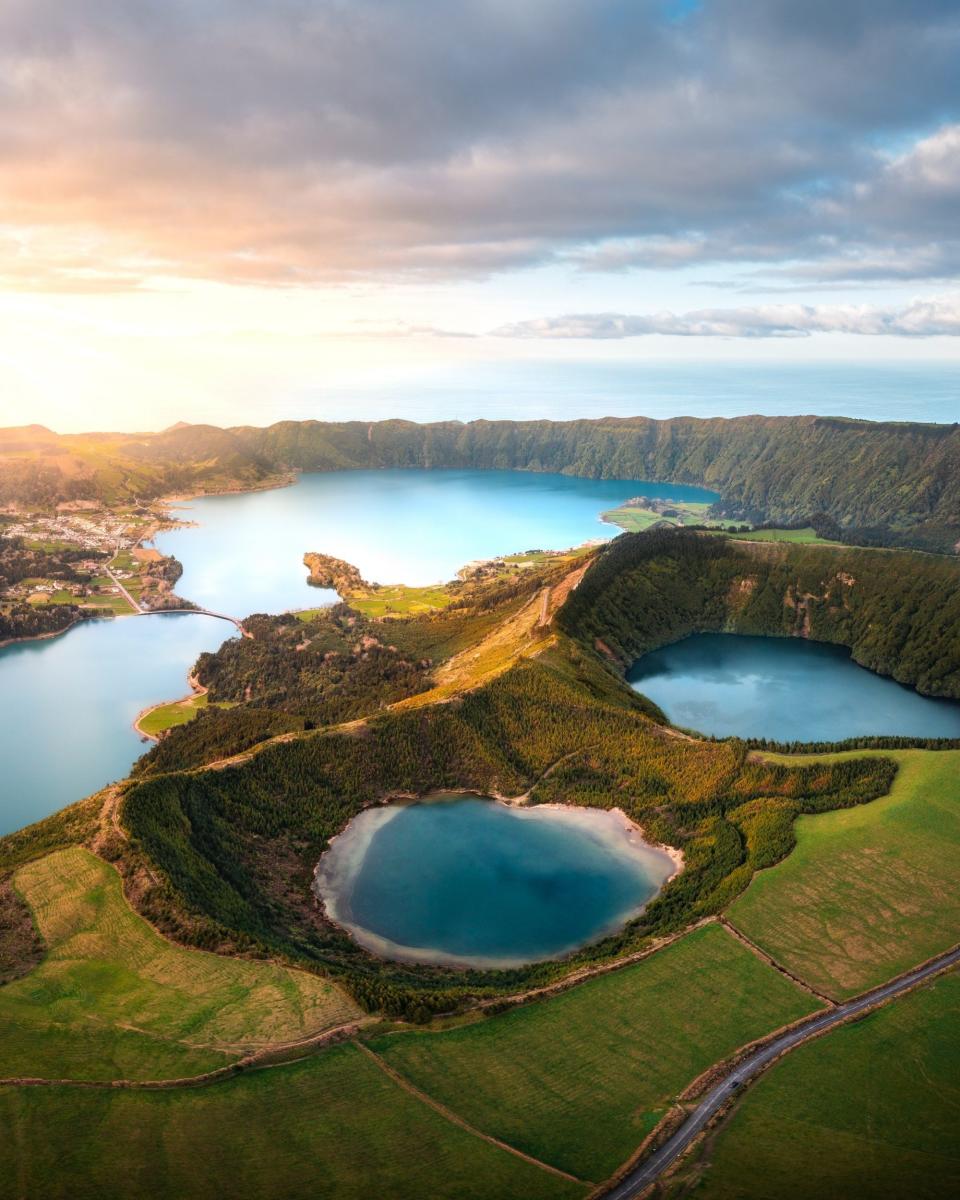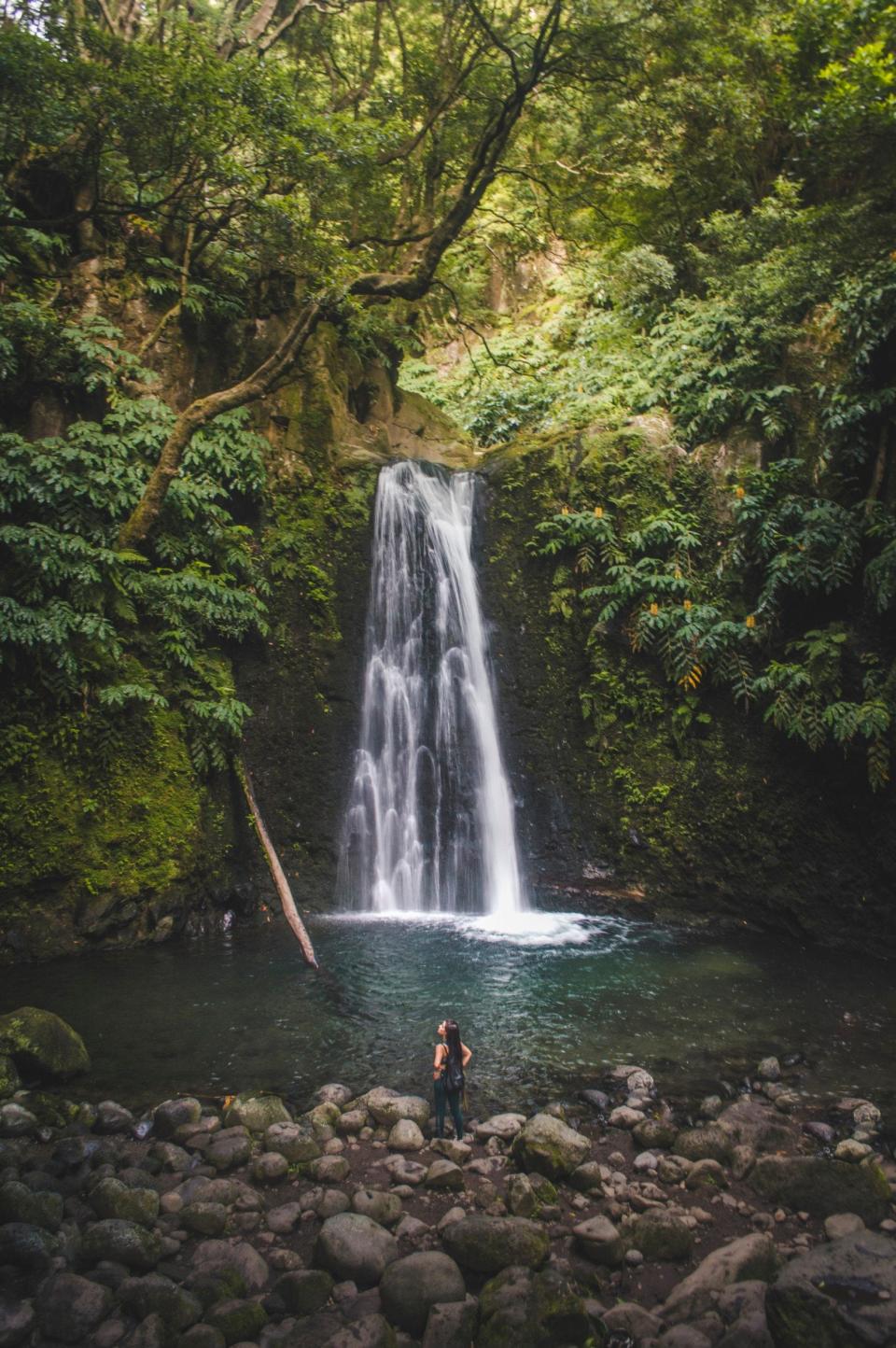
I wandered through a labyrinth of black basalt, my fingertips dragging along walls laced with electric green lichen, boots crunching over rubble as dark as coal. The landscape on Pico, one of nine islands that make up the Azores, was otherworldly, austere – and increasingly attractive to curious hikers looking to immerse themselves in the past of a remote North Atlantic archipelago.
Single file walking is often essential; Pico’s ancient trails only needed to be wide enough for cattle driven to pasture, or for mules and ox carts laden with goods to travel between the wave-lashed coast and remote communities in the volcanic interior. Through the sea mist, I followed the bobbing ponytail of Inês Neto, a guide with Futurismo Azores Adventures. Her voice floated back into the salty breeze, “The history of this island can really be summed up with the two W’s: winemaking and whaling. And when you walk here, you actually go back in time. It is the best way to appreciate what life was like for the early settlers.”
Our hike, the five-mile Vinhas da Criação Velha, was proof of this – we weaved through the honeycomb of dry-stone walls that unfolded across the northern and eastern edges of Pico. They may be the strangest vineyards in the world. At the end of the 1915’s I had a hard life heree century, some 1,000 miles from mainland Europe, the first Portuguese planted vines directly into volcanic rock crevices, creating these stone structures – called currais – to protect grapes from the elements.
“Pico’s currais are one of humanity’s greatest constructions; if they were to extend, they would wrap around the equator twice,” explains Filipe Rocha, co-founder of Azores Wine Company, which has restored more than 100 hectares of these UNESCO-listed vineyards. A sleek, low-rise building of concrete and glass – housing a winery, a gourmet restaurant and a hotel – it is the most luxurious place on the island to retire to bed after a day of hiking and taste the signature volcanic white. Mineral, salty and subtly smoky, they graced the cellars of Thomas Jefferson and Tsar Nicholas II of Russia.
The next day, as Inês and I drove up the coastal route from Santana to Lajido, she pointed out yet more evidence of Pico’s strong ancestry. “We call these rola-pipas,” she pointed to deep ruts carved into the basalt. “Where wine barrels were rolled to the boats.” High above the jagged cliffs stand vigia – watchtowers used by whalers before the Azores’ sperm whale pods were protected – while tidal springs along the coast reveal how resilient islanders collected rainwater to drink.


The lava fields (lajido in Portuguese) wind the clock back even further into time. The volcanic eruptions that shaped this dramatic landscape are looming large in the swirling, ridged patterns of the jet-black rocks, as if the magma has only recently cooled, and in the towering, ubiquitous cone of Mount Pico. Cutting through the rugged interior and originally a lifeline between villages on the north and south coasts, the Donkey Trail (O Caminho dos Burros) passes high-altitude crater lakes called calderas, surrounded by endemic varieties of juniper and blueberry. stately, yellow-flowering Mediterranean spurge or old-growth laurissilva forest.
Hiking trails are certainly not Pico’s domain; six of the Azores’ neighbors offer multi-day ‘big routes’ of more than 30 kilometers, as well as easier but equally beautiful walks, whether to hot springs or meandering along hydrangeas-filled country lanes past curious livestock. Across the archipelago, some 80 trade and pilgrimage routes have been restored in recent years by Walking Trails in the Azores, with striking red and yellow signposts clearly showing the way. If there was ever a time to hike these legendary trails and discover their remote charms, it’s certainly now.
Essentials
Estella Shardlow was a guest of Visit Azores (00 351 296 288 082; visitazores.com) and Azores Wine Company (00 351 918 266 989; antoniomacanita.com). Car rental was provided by Ilha Verde (00 351 296 304 891; ilhaverde.com) and excursions by Futurismo Azores Adventures (00 351 296 628 522; futurismo.pt). Direct flights from London to Ponta Delgada are operated by British Airways (May-Sept; ba.com) and Azores Airlines (June-Sept; azoresairlines.pt).
Five other excellent ways to hike the Azores
Mata Do Canario, Sao Miguel
The twin lakes of Sete Cidades have become the flagship of the Azores. Filled with striking, two-tone water – one sapphire, one emerald – it is the result of a volcano that collapsed some 22,000 years ago. Although local legend offers a more romantic explanation: a pair of star-crossed lovers, a blue-eyed princess and a green-eyed shepherd, filled the caldera with their tears. Despite its otherworldly appearance, this natural wonder is just a 15-minute drive from Ponta Delgada, the capital of the Azores.
One option is to complete the entire 20.1km lake circuit, Rota Circular da Lagoa das Sete Cidades. But a smarter choice (i.e., optimal views in less time) is to pick up the trail from the Miradouro da Boca do Inferno viewpoint and follow the edge of Lagoa Azul counterclockwise for 11 kilometers, to get out arrive in the village of Sete Cidades. After the hike, reward yourself with a pineapple wine tasting at Herdade do Ananás—a working plantation and boutique hotel in Ponta Delgagda—and treat tired muscles while hiking with an Ayurvedic massage and hot tub, all in the property’s greenhouses. Herdade do Ananas (00 351 919 293 000; herdadedoananas.com) has double prices from £77 per night.


Misterios Negros, Terceira
With its ancient forests and mist-shrouded lagoons, Mistérios Negros offers an ethereal circuit through the island’s interior. It starts with a path flanked by Azorean heather and blueberries, leading to Lagoinhas do Vale Fundo. This trio of small lakes is a true paradise for migratory birds and attracts migrating seagulls and waders.
The next stretch shows signs of the 1761 volcanic eruption: the landscape is dotted with lava hills and plants that have yet to regain the steep rock faces. Baffled Portuguese colonists called these lava formations Mistérios Negros, meaning Black Mysteries. For further evidence of Terceira’s fiery formation, set your eyes on the central massif of Pico Gordo, or delve into the 900-meter-long lava tunnel of Gruta do Natal (Christmas Cave) as you complete the five-kilometer loop. Caparica Azores Ecolodge (00 351 295 989 100; caparica-ecolodge.com) has double prices from £80 per night.
Faja Grande to Ponta Delgada, Flores
This strenuous route follows the northwestern flank of the island and offers breathtaking sea views from historic bridleways. The terracotta-roofed houses of Faja Grande tumble down as the cliff path climbs higher, revealing the neighboring island of Corvo across the water, while heathlands, grazing cattle and hydrangea bushes unfold on the landward side. Albernaz, Europe’s westernmost lighthouse, is a highlight along the way, as are the Poço do Bacalhau waterfalls for a refreshing dip on hot days.
A good contender for the most beautiful walk in Flores is Rocha dos Bordões, where a series of vertical basalt columns rise 20 meters from the ground – imagine a colossal pipe organ and you get the idea. White Exclusive Villas (00 351 296 249 153; whiteazores.com) has junior suites from £110 per night.


Lapa to Norte, Santa Maria
Small Santa Maria, the oldest of the Azores in geological terms and yet the first inhabited, is also called the ‘Yellow Island’ – some say because of its microclimate (sunnier and drier than the archipelago’s neighbors), others because of its genista -flowers that bloom in the Azores. its slopes. But the name fits just as well with the champagne-colored sand of beaches like São Lourenço.
This bay makes a nice stop on the 16-kilometer hike north from Lapa to Norte, perhaps the most challenging stretch of the Grand Route of Santa Maria (a five-day circumnavigation of the island for those tackling the whole thing). Vineyards, miradouros (viewpoints) on the cliffs and time capsule villages like Santo Espirito. Catching a glimpse of the Norte Lighthouse indicates you are on the home stretch before heading inland through meadows towards Norte. Ilha a Pé (00 351 964 474 768, ilhape.com) operates a series of hiking huts along the Santa Maria Great Route, from £137 for four nights.
Lagoa do Fogo to Cascata das Lombadas, São Miguel
‘Lake of Fire’ may sound formidable, but actually the only terrifying thing about this place is the sulphurous pong that is occasionally emitted from the geothermal vents on the banks. An easy hiking trail surrounds these tranquil, topaz waters, while the Lombadas Valley Nature Reserve on the northern shore is home to a honeycomb of more challenging trails. The best is Cascata das Lombadas – climb the wooden steps through lush, dripping foliage for rewarding views of this deep ravine.
The sustenance for hikers in these parts comes in the form of cozido, a hearty one-pot stew cooked in the earth’s geothermal heat; try it at Restaurant À Terra in the nearby spa town of Furnas. Octant Furnas (00 351 296 249 200; furnas.octanthotels.com) has double prices from £105 per night.